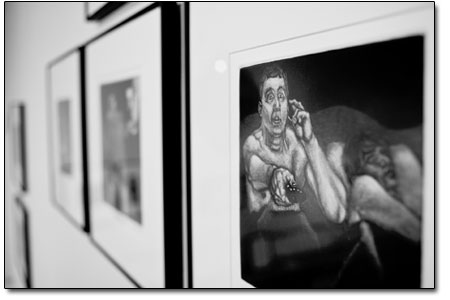|
|
||
|
?Of People and Places?
by Jules Masterjohn y art seeks to awaken memories of spaces and people. These images serve as heart maps: the visual reminders of roads taken, lives known and the many intersections of memory with hope. Often it is in the courage of the unnoticed, or even the irony of our foibles that I am most acutely reminded of my humanity.” Printmaker David Clark presents these words along with more than 20 works in his exhibition of mezzotints, “Of People and Places,” on display in the Durango Arts Center Art Library. “Mezzotint” is a relief printmaking process developed during the early Renaissance. The Italian word translates as “mezzo,” meaning “half,” and “tinta,” meaning “tone,” a reference to the gradations possible with the technique. To make a mezzotint, one begins with the labor-intensive process of abrading a copper plate with texture by rocking a hand tool across the surface. Once textured, an image is created by burnishing and/or scraping away selected areas. The plate will hold varying degrees of ink and produce varying values of light and dark depending upon the surface detail. For example, highly textured areas will print dark whereas totally smoothed areas hold no ink and will print white. Once the work on the copper plate is completed and the image formed, the plate is inked, covered with a wet piece of paper and passed through a printing press. The ink is transferred to the paper via pressure, with the final product being a mezzotint print. Clark said he takes delight in this time-consuming, technical process, with the hand-worked plates being “beautiful in their own right as works of art.” In the interest of helping viewers understand this technique, Clark has included in the exhibit a display of hand tools, a plate and its print. Portraiture, figurative works and florals are presented in the exhibit. In his delicate image, “Terry’s Gift,” the subject is slowly revealed through the interplay of contrasting values and combinations of geometric and organic shapes. Strong light from a window isolates two figures. The dark silhouettes merge with a grid structure that defines a window casement. Cast shadows and reflections are present. This is a complex composition and easily attracts the eye. Within the mezzotint process, stillness is captured. The velvety darkness that is held in the blackest of blacks absorbs any busyness of the mind or heart. Clark’s print, “The Half You See” shows this most effectively. A self-portrait, it shows a bit more than half of the artist’s face tightly cropped in the picture plane. The head fades into dark, silent black as it recedes in space. The white of the eye draws our attention. Simultaneously, one’s gaze is absorbed into the inescapable emptiness of the other half of Clark’s composition. In “The Half You See” Clark utilizes the mezzotint process to its full potential. The portrait is naturalistically rendered with the many tonal variations that would be seen if we were looking at a face before us. This print describes the power and unique quality of the technique, which produces a subtle range of values in the hand of an experienced printmaker. This is his most accomplished print in the exhibit. “A Gluttony of Opinion” is also a close-cropped portrait surrounded by complete darkness. A finger pokes into the sitter’s ear along with four other fingers fencing off part of the pursed mouth. This image embodies the realities of judgment making, where no listening occurs and partial-truths are spoken. The deeply wrinkled fingers and puckered cheeks show the rumpled surface of the skin, a metaphor, perhaps, for the rough terrain that strong opinions encounter. Clark’s rendering is more cartoonish, like that found in his series “Cell Phone Madness.” In these works, line more so than value defines the features of his figures. Awkwardly realized, showing unconvincing foreshortening and little convincing depth, these images suffer from this linearity. Or, perhaps this style is intentionally used to reinforce the theme of clumsy and misplaced use of technology. In the latter case, it is effective. Mezzotint offers a delicate range of value and tone that defines shape to create the illusion of three-dimensionality. In many of his prints, Clark has not exploited this quality to its fullest. If he is attempting figurative realism, I am not convinced. If he is working toward a naïve style, he is headed in the right direction. The landscape genre seems like a rewarding direction for him. In his print “Whispers,” billowing clouds fill the sky with subtle tones and set off the dark silhouette of a treetop. Through the laciness of leafy branches, one’s point of view is skyward. This is a lovely image and well fulfills Clark’s intentions. “It is my hope that the viewer of my work, perhaps struck by the stark graphic simplicity, will be caught up in a stillness; an intentional quiet that is accompanied by thoughtful and reflective, imaginative moments.” • “Of People and Place” is on display through May 7 in the Art Library upstairs at the Durango Arts Center. Hours are Mon. through Sat., 10 a.m. - 5 p.m.
|


